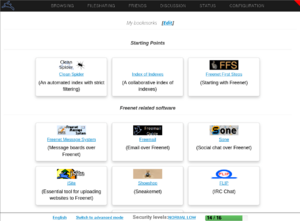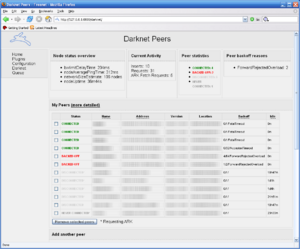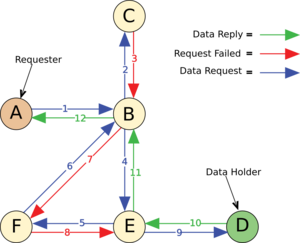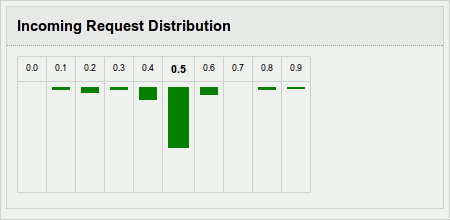Hyphanet facts for kids
 |
|

FProxy index page (Hyphanet 0.7)
|
|
| Initial release | March 2000 |
|---|---|
| Stable release | |
| Preview release |
Lua error in Module:Wd at line 1575: attempt to index field 'wikibase' (a nil value).
|
| Written in | Java |
| Operating system | Cross-platform: Unix-like (Android, Linux, BSD, macOS), Microsoft Windows |
| Platform | Java |
| Available in | English, French, Italian, German, Dutch, Spanish, Portuguese, Swedish, Norwegian, Chinese, Russian |
| Type | Anonymity application, peer-to-peer, friend-to-friend, overlay network, mix network, distributed data store |
| License | GNU General Public License version 3 only |
Hyphanet (called Freenet until mid-2023) is a special computer program. It helps people communicate online without being easily tracked. It's like a secret club for sharing information.
Hyphanet uses a distributed data store. This means information is stored in small pieces across many computers. This makes it hard to censor or block. It's designed to help people share ideas freely and privately.
Contents
How Hyphanet Works
Hyphanet helps you stay private online. It stores small, encrypted parts of information on many users' computers. When you ask for information, your request travels through several other computers. These computers pass the request along without knowing what you are looking for.
This is similar to how routers send data on the internet. But Hyphanet adds strong encryption and doesn't rely on one main server. This way, users can share or get information anonymously.
Hyphanet's Journey Through Time
Hyphanet has been developed continuously since 2000. It keeps getting updates to make it better and safer.
Major Updates to Hyphanet
Hyphanet 0.7 was a big update released in 2008. It added a new way to connect called "darknet." This mode lets you connect only to friends you trust. There's also an "opennet" mode, where you connect to any other Hyphanet user. You can use both at the same time.
The darknet mode makes it very hard for outsiders to know you are using Hyphanet. This version also changed how messages are sent, making them faster.
Hyphanet 0.7.5 came out in 2009. It used less computer memory and made finding and sharing content faster. It also improved the web interface, which is how you browse sites on Hyphanet. Many small bugs were fixed, and it became easier to use.
In 2015, Hyphanet stopped using an old database system. This helped prepare for new features that fight spam. Hyphanet has always been free software. In 2011, it became compatible with OpenJDK, which is a free version of Java.
In 2015, Hyphanet won an award for "protection against total surveillance." This shows how important its privacy features are.
Using Hyphanet
Hyphanet is different from other file-sharing programs. It separates the network from how users interact with it. This means there are many ways to use Hyphanet.
Browsing Freesites
The easiest way to use Hyphanet is through FProxy. This is a web interface built into the program. You can use it to browse "freesites." These are websites that use normal HTML but are stored on the Hyphanet network, not on a regular web server. You also use this interface to change settings.
Other Ways to Interact
You can use other programs or plugins with Hyphanet. These let you do things like join forums (similar to online message boards) or share files.
Hyphanet is not like a regular proxy for the internet. It can only access content that has been put into the Hyphanet network. It's more like Tor's onion services than a tool to browse the regular internet anonymously.
Privacy and Sharing
Hyphanet focuses on free speech and privacy. It tries to protect the identity of people who put data into the network (uploaders) and those who get data from it (downloaders). Once a file is uploaded, the original uploader doesn't need to stay online. The file is broken into pieces and stored on many computers in the network. When you download, these pieces are found and put back together.
Every computer running Hyphanet helps by storing parts of files and helping requests travel. Because of privacy, the computer asking for content doesn't connect directly to the computer that has it. The request goes through several other computers. None of these computers know who asked for the data or where it came from. This means transferring files can sometimes be slower, especially for content that isn't accessed often.
Since version 0.7, Hyphanet has two security levels: opennet and darknet. Opennet connects to any user. Darknet connects only to "friends" you've chosen. You can use both together.
Why Hyphanet Matters
Hyphanet's creators believe that true freedom of speech needs true privacy. They think the good uses of Hyphanet are more important than any negative ones. They believe that information itself is not a crime. Hyphanet tries to make sure no group can decide what information is allowed or blocked. What one group finds okay, another might find offensive. Hyphanet's goal is to ensure no one can control what information is available.
It's hard to know how much Hyphanet is used in countries where information is controlled. One group, Freenet China, tried to share Hyphanet software in China starting in 2001. They sent it through emails and on disks after their website was blocked. In 2002, Freenet China reportedly had thousands of users. However, opennet traffic on Hyphanet was blocked in China around 2010.
How Hyphanet is Built
The Hyphanet network stores documents and lets you find them later using a special code called a "key." The network is designed to keep working even if parts of it go offline. It has no central servers, so no single person or group controls it. The program code is very large, with over 192,000 lines of code.
Information on Hyphanet is spread out and stored on many different computers. Data is encrypted, which means it's scrambled. This makes it hard to know who put content into Hyphanet, who asked for it, or where it's stored. This protects users' privacy and makes it very hard to block specific content. Even the person running a Hyphanet computer can't easily tell what's stored on it because it's encrypted.
Storing and Caching Data
Hyphanet doesn't just send data; it also stores it. Each computer running Hyphanet sets aside some disk space to store data, usually several gigabytes. Files are broken into many small pieces, and extra copies are made for safety. Each piece is handled separately, so one file can have parts stored on many different computers.
Here's how sharing works:
- A user who wants to share a file "inserts" it into the network.
- Once inserted, the original computer can go offline. The file is now stored in the network and will be available to others. No single computer is responsible for the content; it's copied to many different computers.
This design has two main benefits: it's very reliable, and it protects privacy. Information stays available even if the original uploader goes offline. It's also spread anonymously as encrypted pieces, not whole files.
A downside is that if a piece of data isn't asked for often, and a computer gets new data, it might eventually delete the old data to make space. So, Hyphanet tends to "forget" data that isn't used regularly.
You can put data into the network, but you can't delete it. Because Hyphanet is anonymous, the original uploader is unknown. The only way data is removed is if no one asks for it anymore.
The Hyphanet Network
Typically, a computer on the network runs the Hyphanet software, which acts as a "node." This node connects to other nodes, forming a large network. Some nodes are used by people to request and view documents. Other nodes just help route data. All nodes communicate the same way; there are no special "clients" or "servers."
Hyphanet is designed to work on complex networks like the internet. Each node only knows about a few other nodes it can connect to directly. When a message is sent, it travels from one neighbor node to another until it reaches its destination. As a node passes a message, it doesn't know if the next node is the final destination or just another stop. This helps protect the privacy of users.
Each node keeps a storage area for documents and a table that tracks how well other nodes have helped find different keys.
The Hyphanet Protocol
The Hyphanet protocol uses a "key-based routing" system. This is similar to how distributed hash tables work. In Hyphanet 0.7, the way requests are routed changed a lot.
Every node has a "location," which is a number. When you ask for a key, the node first checks its own storage. If it's not there, the key's unique code (hash) is turned into a number. The request then goes to the node whose location is closest to that number. This continues until the data is found or a certain number of hops (steps) is reached. If the data is found, it's saved on each node along the path. This means there's no single source for a key, and trying to find where it's stored will just make it more widely available.
The same process is used to put a document into the network. The data travels based on its key until it runs out of hops. If no existing document is found with the same key, it's stored on each node.
This system works best if the node locations are grouped correctly. Hyphanet assumes that the darknet (a part of the social network) is a small-world network. Nodes constantly try to swap locations to be closer to their neighbors. If the network is a small-world network, Hyphanet should find data fairly quickly.
Eventually, the document is found, or the search limit is reached. The last node sends a reply back to the original sender. The nodes along the way can choose to save the document. This saves bandwidth and makes documents harder to block because there's no single "source node."
How Nodes Specialize
When a darknet starts, node locations are random. This means requests travel randomly. But over time, nodes that are close to each other will have similar locations. Data with similar keys will be stored on the same node.
The network organizes itself into groups where nodes tend to hold data items that are "close" to each other in the key system. There will likely be many such groups across the network. A document might be copied many times, depending on how much it's used. This means that data used less often will be on a few specialized nodes. Data used often will be spread widely. This automatic copying helps when many people want the same information.
Understanding Keys
Keys are like unique codes for documents. They are created using a hash function. There are two main types of keys in Hyphanet:
- Content Hash Key (CHK): This is a unique code for a document after it's encrypted. A node can check if the document is correct by creating its own code and comparing it to the key. CHKs ensure content hasn't been changed. They also help save space because the same data will always have the same CHK.
- Signed Subspace Key (SSK): These keys use public-key cryptography. Documents inserted with SSKs are signed by the person who put them there. This signature can be checked by any node to make sure the data hasn't been tampered with. SSKs can be used to create a verifiable identity on Hyphanet. A special type of SSK, the Updatable Subspace Key (USK), adds version numbers so content can be securely updated.
Opennet vs. Darknet
Since version 0.7, Hyphanet supports both "darknet" and "opennet" connections. Opennet connections are made automatically by nodes that have this feature turned on. Darknet connections are set up manually between users who know and trust each other. Hyphanet developers say this trust means your friend "will not break into their Hyphanet node."
Opennet connections are easy to use. Darknet connections are more secure against attackers on the network. They can make it hard for an attacker (like a government trying to block access) to even know that someone is running Hyphanet.
The big idea in Hyphanet 0.7 was to allow a darknet that could grow very large, possibly supporting millions of users. Older darknets were limited to small, separate networks. Hyphanet's darknet can scale because human relationships often form small-world networks, which means there are short paths between any two people. The routing system can also use a mix of opennet and darknet connections. This lets people with only a few friends on the network still get good performance while keeping some of the security benefits of darknet connections.
Tools and Applications

Hyphanet itself doesn't do everything. It's like a base that other programs can build on. It has an API (a set of rules for how programs talk to each other) called Freenet Client Protocol (FCP). Other programs use FCP to create services like message boards, file sharing, or online chat.
Communication Tools
- Freenet Messaging System (FMS): This was made to fix problems with another tool called Frost, like spam. Users publish lists of people they trust. Each user only downloads messages from people they trust, or people trusted by those they trust. FMS is developed anonymously and can be found on a "freesite" within Hyphanet. It lets you have many identities and delays posts randomly. It's a separate program that uses FCP to connect to Hyphanet.
- Frost: This tool helps with file sharing. It can be downloaded from its home page or from a "freesite" within Hyphanet. It's also a separate Java program.
- Sone: This tool has a simpler look, like Facebook. It allows public anonymous discussions and image galleries. It can also be used to add comments to regular websites on the internet.
Utilities
- jSite: This tool helps you upload websites to Hyphanet. It handles the special keys and manages uploading files.
- Infocalypse: This is an add-on for a system called Mercurial (which tracks changes in computer code). It helps get new data with fewer requests and lets you support a code library by securely re-uploading parts of the data without needing the owner's private keys.
Notability
Hyphanet has been featured in major news outlets like The New York Times, CNN, 60 Minutes II, the BBC, and The Guardian.
Hyphanet received the SUMA-Award in 2014 for "protection against total surveillance."
Freesite
A "freesite" is a website hosted on the Hyphanet network. It contains only static content, meaning it can't have active parts like server-side scripts or databases. Freesites are coded in HTML and support features that your web browser allows. However, the Hyphanet software will remove parts of the code that might reveal your identity, such as code that tries to access something on the regular internet.
See also
 In Spanish: Hyphanet para niños
In Spanish: Hyphanet para niños
- Peer-to-peer web hosting
- Rendezvous protocol
- Anonymous P2P
- Crypto-anarchism
- Cypherpunk
- Distributed file system
- Freedom of information
- Friend-to-friend
Comparable software
- GNUnet
- I2P
- InterPlanetary File System
- Java Anon Proxy (also known as JonDonym)
- Osiris
- Perfect Dark – also creates a distributed data store shared by anonymous nodes; the successor to Share, which itself is the successor of Winny
- Tahoe-LAFS
- ZeroNet




